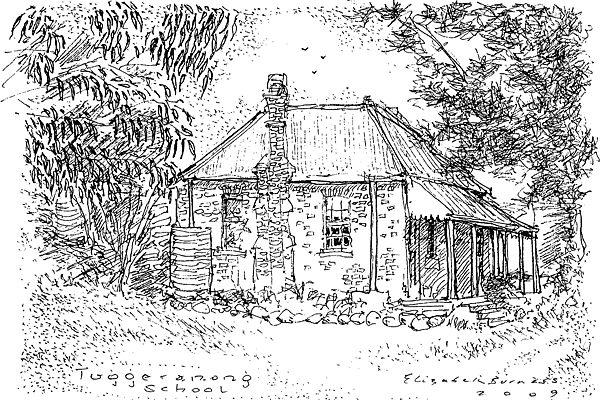The Tuggeranong Schoolhouse
Tuggeranong Public School Names 1908
Back Row, left to right
Wilf Monk, Gallagher, Ken Gibbs, Darcy McGee, Unknown, Evlyn Grady.
Third Row, Left to Right
Mr Frank McGee, Unknown, Violet Monk, Gibbs, Kath McGee, Grady, Gallagher,
Mrs Frank McGee.
Second Row, Left to right
Peter Gallagher, Michael McGee, Unknown, Phil McGee, Irish Monk, Unknown.
Front row, Left to right
Unknown, Pat McGee, Unknown, Mary McGee, Moran, Grady.
Courtesy of Errol Lea-Scarlet.
From: Elizabeth Burness
The Tuggeranong Valley is very fortunate in that it has three long established house museums, Lanyon Homestead, Mugga Mugga Cottage and Calthorpe’s House, and now it has added an exciting Schoolhouse Museum. Set in an acre of land, surrounded by suburbia, this new Museum nestles against Simpson’s Hill in the suburb of Chisholm.
The property is excellent for examining the layering of history because of the proximity of the natural bushland and the fact that the successive schoolmasters ran a forty acre farm. Now only one acre survives and the rest is suburbia. The Tuggeranong Schoolhouse was built in 1880 by Sanders Helman, and there are extensive records of the history of the building. A comprehensive and thorough Conservation and Management Plan was done in 1984 by Philip Cox and Associates. The brick building has a unique charm and is in such good order that its architecture and building materials, especially the use of Australian cedar, are a feature.
The school and its attached four room cottage and kitchen extension, added in 1899, was used for sixty years until falling attendance by 1939 forced the school to close. The cottage was tenanted for seventy years until the ACT Government extensively renovated it in the last two years. I then took it over and opened it to the public.
The school operated through the Victorian and Edwardian eras, as well as through the reigns of George the V and George VI. It also changed from the NSW to the ACT governments. It covers the time of the Boer War and the First World War and the time of Federation and the Great Depression, so there is a rich historical framework it fits into.
One of the teachers, Francis McGee, and his family, lived in the house from 1898 until 1927. The school and house have been given heritage listing because one of his sons, James, born in 1903, became an internationally renowned nuclear physicist, and a pioneer of television.
Only one school photo has so far been found of McGee’s time at the school. It shows McGee and his wife, six of their seven children, and the rest of the class, in 1908. This fits beautifully into the ‘Towards 2013’ Canberra celebrations. It was possible to furnish the house reflecting this period. I was able to research documents held in the ACT Archives and found an inventory of all the items in the schoolroom when the new ACT government took over administration of all the schools in the Territory.
Currently the schoolroom has desks from different eras, and visitors enjoy the slate and pen and ink experience. Documents, particularly a copy of the punishment book, as well as ‘hands on’ books and other classroom paraphernalia, have been well received by visitors, both young and old.
The acre of land has been relatively undisturbed. It has a circa 1936 garage and in the mid 1950’s farm buildings were added to the schoolhouse building and brick toilet, by one of the tenants. Electricity was not connected until the 1950’s, making James McGee and his research even more remarkable. Early technology such as crystal sets and toy steam engines are on display in the children’s bedroom to suggest young James’s remarkable interests, and to contrast with more familiar playthings such as dolls and spinning tops.
Because the property has been undisturbed, a little archaeology has been done and some items uncovered are on display in the classroom. The layers of history may be extended as an application for a Heritage Grant to employ professional archaeologists to run a public ‘dig’ on the site, has been submitted. The focus will be the 1880 toilet. Some of the ‘finds’ will be added to the display in the classroom.
The other unique feature of the property is the involvement of the descendants of the McGee family who have generously lent family photographs, as well as happily interacting with visitors on open days. This involvement has enabled me to write ‘voices’ for each room, adding another empathetic form of interpretation.
There are four areas for visiting schoolchildren studying past and present. They are the schoolroom and the cottage, the site and a ‘hands on’ play area with toys from the past. Schools are also encouraged to factor in a visit to Simpson’s Hill to expose the students to the natural environment as well as to the built environment of the fascinating schoolhouse museum.
The classroom and cottage have been furnished in period style since March
2011. I have met the challenge of running this museum with great enthusiasm
and I am keen to maintain my original and innovative interpretations of
the past, as I have done for the last ten years under the banner of, ‘History
With A Difference’. See www.historywithadifference.com.au for more information.
Elizabeth Burness
27 June 2011

